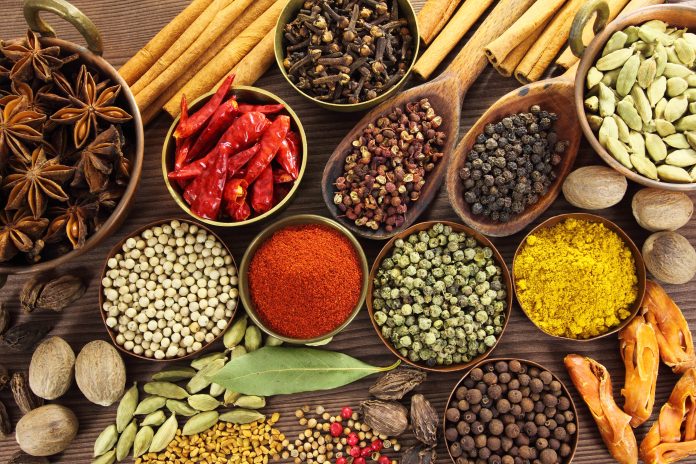By Anu V Pai
Spices have emerged as one of the factors contributing to the country’s rising food inflation rate, along with vegetables and pulses. Consumers are feeling the pinch of rise in prices of spices, some of which have skyrocketed. Although spices have been trending higher overall since the COVID-19 pandemic, in 2023 certain spices such as jeera, fennel, chilli, black pepper, turmeric, ginger, etc. saw significant rallies.
Jeera reached a record high and was quoted above ₹62,000 per quintal in the important spot market of Unjha, Gujarat before easing toward the end of the year 2023. Similar fluctuations were observed in the price of chillies. Prices of ginger and turmeric eased at the end of 2023 following a spike between July and September. The price for ginger exceeded ₹40,000 per 100 kg in August before easing. Black pepper prices broke the ₹60,000 per 100 kg mark and hit a five-year high, while small cardamom prices increased to a three-year high, with average auction prices approaching ₹2,000 per kg.
Several factors for the surge
A combination of factors has created a supply-demand imbalance which has fueled the price rise. Amidst strong export and domestic demand, several factors like low yields, shifting weather patterns, delayed and erratic south-west monsoon, farmers switching from growing spices to other crops, pest attacks, etc., caused the supply to fall behind. Spices are generally weather-sensitive crops and require optimal temperatures, rainfall, and climatic conditions for good yields.
Among the exchange-traded spices, jeera prices surged to an all-time high of ₹64,000 per 100 kg on NCDEX in 2023 but then ended largely flat and is currently trading close to its lowest level in one year. The decline in production for the last two years, unfavourable weather, and lower carry-over stocks amidst strong demand had propelled the bull run in jeera. However, in the 2023-24 rabi season, the production of jeera is seen increasing due to higher acreage and favourable weather conditions prevailing in the major jeera-growing states of Gujarat and Rajasthan so far, weighing on prices.
31% lower exports
According to the Gujarat State Agriculture Department, as of January 15, 2024, jeera has been sown on 5,61,306 hectares compared with 2,75,830 hectares a year ago, up 160.07 per cent from the normal area. In Rajasthan, jeera was sown across 6,87,781 hectares as of January 1, 2024, according to the data from the State’s Agriculture Department. The decrease in exports is also affecting the price of jeera. The Spices Board has reported that the export of jeera in the first half of the FY 2023-24 was 84,475.41 tonnes, which is around 31 per cent lower than the same period in the previous financial year. Competitiveness of Indian jeera is low in overseas market as cumin from Syria and Turkey is available at cheaper rates.
Turmeric prices on NCDEX gained over 70 per cent in 2023. The yellow spice hit a record high of ₹16,720 per 100 kg earlier in August 2023. A delay in sowing this kharif season, erratic monsoon and concerns over yield are pushing up turmeric prices amidst robust export demand. Sowing of the yellow spice is reported lower in the 2023-24 kharif season by 10-20 per cent in Maharashtra, 10-15 per cent in Tamil Nadu and by 18-22 per cent in Telangana and Andhra Pradesh, respectively. Farmers opting for more remunerative crops such as oilseeds, cotton etc too led to lower acreage this season. In the meantime, exports of turmeric are seen firm. According to the Spices Board, 1,02,162.95 tonnes of turmeric were exported during April-October 2023 compared with 99,545.89 tonnes during the same period last year.
Coriander flavour to flourish
In the meantime, coriander is seen firming up after posting yearly losses in 2023. After hitting a two-and-a-half-year low in June 2023, coriander is seen gathering strength on firmer export demand. Data from the Spices Board shows that coriander exports jumped to 67,120.65 tonnes in the April-August period in 2023 compared with 18,557.72 tonnes exported during the same period last year, a jump of more than 261 per cent. Also, concerns over lower acreage this rabi season are lending support. In Gujarat, coriander is sown under 1,27,019 hectares as of January 15, 2024, compared with 2,22,792 hectares during the same period last year, while in Rajasthan it stood at 48,675 hectares as of January 1, 2024.
With the harvest of many of spices such as jeera, coriander, turmeric, garlic, and ginger beginning from the January-February period, significant fluctuations can be expected in the coming days depending upon the arrival of fresh crops. Climatic conditions along with demand, both domestic and export, will shape the market sentiments. The ongoing tension in the Red Sea is also seen impacting the spices market as it could lead to supply chain disruptions and increase costs.
First published in The Hindu Businessline









